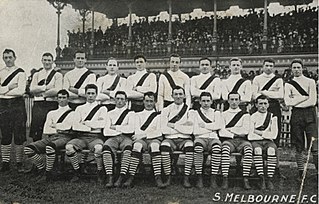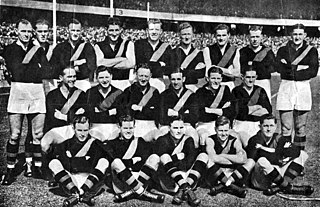Related Research Articles
Melbourne University Football Club, often known simply as University, is an Australian rules football club based at the University of Melbourne. The club fields two teams, known as the "Blacks" and "Blues", who both compete in the Victorian Amateur Football Association (VAFA) in the William Buck Premier Division.

The 1899 VFL season was the third season of the Victorian Football League (VFL), the highest level senior Australian rules football competition in Victoria. The season featured eight clubs, ran from 13 May until 16 September, and comprised a 14-game home-and-away season followed by a finals series featuring all eight clubs.

The 1909 VFL season was the 13th season of the Victorian Football League (VFL), the highest level senior Australian rules football competition in Victoria. The season featured ten clubs, ran from 1 May until 2 October, and comprised an 18-game home-and-away season followed by a finals series featuring the top four clubs.

The 1921 VFL season was the 25th season of the Victorian Football League (VFL), the highest level senior Australian rules football competition in Victoria. The season featured nine clubs, ran from 7 May until 15 October, and comprised a 16-game home-and-away season followed by a finals series featuring the top four clubs.

The 1923 VFL season was the 27th season of the Victorian Football League (VFL), the highest level senior Australian rules football competition in Victoria. The season featured nine clubs, ran from 5 May until 20 October, and comprised a 16-game home-and-away season followed by a finals series featuring the top four clubs.

The 1924 VFL season was the 28th season of the Victorian Football League (VFL), the highest level senior Australian rules football competition in Victoria. The season featured nine clubs, ran from 26 April until 27 September, and comprised a 16-game home-and-away season followed by a finals series featuring the top four clubs.

The 1925 VFL season was the 29th season of the Victorian Football League (VFL), the highest level senior Australian rules football competition in Victoria.
The 1928 VFL season was the 32nd season of the Victorian Football League (VFL), the highest level senior Australian rules football competition in Victoria. The season featured twelve clubs, ran from 21 April until 29 September, and comprised an 18-game home-and-away season followed by a finals series featuring the top four clubs.

The 1931 VFL season was the 35th season of the Victorian Football League (VFL), the highest level senior Australian rules football competition in Victoria. The season featured twelve clubs, ran from 2 May until 10 October, and comprised an 18-game home-and-away season followed by a finals series featuring the top four clubs.

The 1936 VFL season was the 40th season of the Victorian Football League (VFL), the highest level senior Australian rules football competition in Victoria. The season featured twelve clubs, ran from 2 May until 3 October, and comprised an 18-game home-and-away season followed by a finals series featuring the top four clubs.
The 1941 VFL season was the 45th season of the Victorian Football League (VFL), the highest level senior Australian rules football competition in Victoria. The season featured twelve clubs, ran from 26 April until 27 September, and comprised an 18-game home-and-away season followed by a finals series featuring the top four clubs.

The 1944 VFL season was the 48th season of the Victorian Football League (VFL), the highest level senior Australian rules football competition in Victoria.

The 1946 VFL season was the 50th season of the Victorian Football League (VFL), the highest level senior Australian rules football competition in Victoria.
Eric James Edward Fleming was an Australian rules footballer who played for the Geelong Football Club in the Victorian Football League (VFL), and for the Oakleigh Football Club in the Victorian Football Association (VFA).
The Leopold Football Club was an Australian rules football club that competed in junior competitions in Melbourne from the late 1890s until 1924. The club was affiliated with Victorian Football League senior club South Melbourne.
The Victorian Junior Football Association (VJFA) was an open age Australian rules football competition and administrative body. It was the first successful junior football competition in Melbourne, and was in existence from 1883 until 1932. For most of its history it was a competition of independent junior level clubs, before it eventually transitioned to become the second eighteens competition for the senior Victorian Football Association.

The AFL reserve grade competition, commonly known simply as the AFL reserves, was an Australian rules football competition that operated as a second-tier competition to the Australian Football League from 1919 until 1999.
The 1919 VJFL season was the 1st season of the Victorian Junior Football League (VJFL), the Australian rules football competition operating as the second-tier competition to the Victorian Football League (VFL).
The 1923 VJFL season was the 5th season of the Victorian Junior Football League (VJFL), the Australian rules football competition operating as the second-tier competition to the Victorian Football League (VFL).
The 1925 VFL seconds season was the 7th season of the VFL seconds competition, the Australian rules football competition operating as the second-tier competition to the Victorian Football League (VFL). This was the first season under this name, having been renamed from the Victorian Junior Football League (VJFL) at the end of the previous season.
References
- ↑ "League Seconds Final". The Argus. Melbourne. 4 October 1924. p. 32.
- ↑ "Football – second eighteens". The Argus. Melbourne. 15 October 1924. p. 14.
- ↑ "V.F.L. SECONDS". Trove. The Age.
- ↑ "Leopold". The Age. Melbourne, VIC. 18 March 1925. p. 18.
- ↑ "1924 Seconds scores". Tigerland Archive.